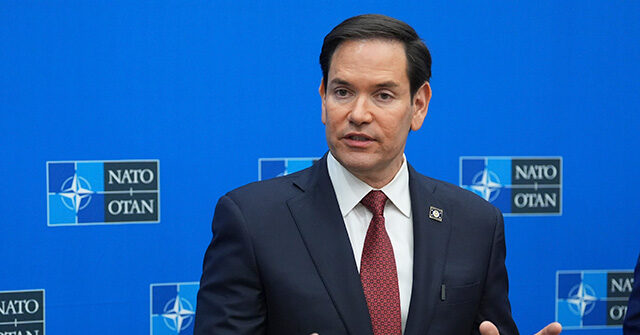U.S. Secretary of State Marco Rubio asked allied foreign ministers gathered in Brussels on Thursday to increase their defense spending to five percent of their gross domestic products (GDP) – a very substantial increase for most members of the North Atlantic Treaty Organization (NATO), and considerably more than the even the United States spends as a percentage of GDP.
“We do want to leave here with an understanding that we are on a pathway, a realistic pathway, to every single one of the members committing and fulfilling a promise to reach up to 5 per cent of spending,” Rubio said from Brussels.
“No one expects that you’re going to be able to do this in one year or two. But the pathway has to be real,” he said.
Canadian Foreign Minister Melanie Joly seemed rather cool to Rubio’s request. “I replied that the U.S. was at 3.2%,” she told reporters in Brussels.
This is much less of a mike-drop response than Joly seems to think, given the titanic size of both America’s GDP and military spending. The U.S. spent $916 billion on defense last year, which is far more than most of its allies combined, and in fact constitutes about 40 percent of the military spending for the entire world.
Canada, on the other hand, is currently spending just 1.37 percent of its far smaller GDP and has pledged only an anemic increase to 2.0 percent. Getting to five percent would require about $100 billion more in military spending than Canada laid out last year.
“We are living in a much more dangerous world, not only because of what’s going on in Ukraine, not only because China has carried out the biggest military buildup in peacetime in recent history and not only because they’re partnering together with Russia in the Arctic,” Joly conceded.
French Foreign Minister Jean-Noel Barrot chimed in by saying France has a self-professed “objective” of reaching three percent to 3.5 percent, “which is about the level of American defense spending.” France spent a little over two percent of its GDP on defense last year.
Barrot added that increased defense budgets in Europe should be spent on buying European-made weapons and equipment, not the American equipment that most NATO countries have bought heavily in years past.
“5% is of course much more than the U.S. itself spends and it’s a very high ambition and we are not ready to commit to a number at this time. Just as it’s important to spend more, it’s also important to spend more smartly,” Norwegian Foreign Minister Espen Barth Eide said, making the same argument as Joly and Barrot.
Portuguese Foreign Minister Paulo Rangel said five percent is “probably too high” at the moment, but Portugal plans to raise its current 1.55 percent spending to the NATO target of two percent in the coming year.
Rangel said his country would be open to discussing new spending targets at the next NATO summit, which is currently scheduled for June.
Asked if the U.S. would meet its five percent target for defense spending, Rubio responded, “Sure, we’re heading there now.”
For all their talk about the severity of the threat posed by China and Russia, nearly a third of NATO members currently fail to meet the alliance’s target of a mere two percent of GDP in defense spending, the target Canada pledged to meet before Rubio asked for five percent. This general reluctance to meet even NATO’s modest spending targets is not easily reconciled with the enthusiasm of so many European governments for inviting Ukraine to join the alliance.
“We are as involved in NATO today as we have ever been, and we intend to continue to be. But it has to be a real alliance. And that means that our alliance partners have to increase their own capabilities,” Rubio said.
A European official told Reuters on Thursday that, despite this exchange of barbs over defense spending rates, the meeting with Rubio was “very reassuring” and “not confrontational.” The official said Rubio asked America’s allies to “do more,” but there was no “bashing.”
In the near term, Rubio’s talk of five percent spending could be a bargaining tactic, using a high demand to light a fire beneath NATO’s assorted posteriors and get them up to the two percent they were always supposed to be spending.
NATO Secretary-General Mark Rutte said on Friday that member states have already conducted “the biggest increase in defense spending on the European side of NATO since the end of the Cold War” to counter Russia’s invasion of Ukraine, but the alliance is not adamantly opposed to spending more.
“Through the years, working together, Allies have delivered security through strength. From all I heard during the last two days, we are well on track to continue delivering well into the future,” Rutte said.
Rutte said he “absolutely” believes the U.S. remains a reliable partner for NATO after the Trump administration’s criticism.
“There are no plans for them to all of a sudden draw down their presence here in Europe,” he said.
Read the full article here
